
Jan Baptist Lambrechts (baptised 28 February 1680 - after 1731) was an 18th-century Flemish painter. He is mainly known for his genre scenes of drinkers, cooks, maids, vegetable salesmen and dancing farmers. [1]

Jan Baptist Lambrechts (baptised 28 February 1680 - after 1731) was an 18th-century Flemish painter. He is mainly known for his genre scenes of drinkers, cooks, maids, vegetable salesmen and dancing farmers. [1]
Jan Baptist Lambrechts was born in Antwerp as the son of Jacob and Anna Deckers. His parents died when he was still very young. His stepbrother Jeroom Lambrechts allowed him to develop his artistic skills through self study. In 1703 he left for Lille with the purpose of selling paintings at the annual fair. This was followed by years of travelling.
Jan Baptist Lambrechts only returned to Antwerp in 1709 where he became a master of the local Guild of St Luke. [2]


He left his hometown Antwerp in 1731, not long before he died. [3]
Jan Baptist Lambrechts was a genre painter who specialised in tavern scenes and merry company scenes. His preferred motifs included cooks, maids, vegetable salesmen, dancing farmers and drinkers. [1] He also created a singerie depicting a A cat judged by monkeys (At Sotheby's 29 - 30 January 2016 in New York, lot 682). [4]
He was highly appreciated for his fine brushwork and detailed compositions. He was skilled in the rendering of fine fabrics. [1]
Examples of his artistic output can be found in the Uffizi in Florence and the Hermitage and also appear on the international art market.
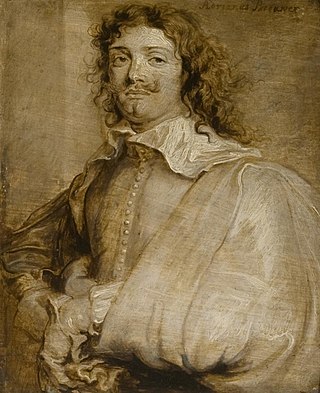
Adriaen Brouwer was a Flemish painter active in Flanders and the Dutch Republic in the first half of the 17th century. Brouwer was an important innovator of genre painting through his vivid depictions of peasants, soldiers and other "lower class" individuals engaged in drinking, smoking, card or dice playing, fighting, music making etc. in taverns or rural settings. Brouwer contributed to the development of the genre of tronies, i.e. head or facial studies, which investigate varieties of expression. In his final year he produced a few landscapes of a tragic intensity. Brouwer's work had an important influence on the next generation of Flemish and Dutch genre painters. Although Brouwer produced only a small body of work, Dutch masters Peter Paul Rubens and Rembrandt collected it.

David Teniers the Younger or David Teniers II was a Flemish Baroque painter, printmaker, draughtsman, miniaturist painter, staffage painter, copyist and art curator. He was an extremely versatile artist known for his prolific output. He was an innovator in a wide range of genres such as history painting, genre painting, landscape painting, portrait and still life. He is now best remembered as the leading Flemish genre painter of his day. Teniers is particularly known for developing the peasant genre, the tavern scene, pictures of collections and scenes with alchemists and physicians.

Adriaen van Utrecht was a Flemish painter known mainly for his sumptuous banquet still lifes, game and fruit still lifes, fruit garlands, market and kitchen scenes and depictions of live poultry in farmyards. His paintings, especially the hunting and game pieces, show the influence of Frans Snyders. The two artists are considered the main inventors of the genre of the pronkstillevens, i.e. still lifes that emphasized abundance by depicting a diversity of objects, fruits, flowers and dead game, often together with living people and animals. Van Utrecht also painted a number of flower still lifes. He was a regular collaborator with leading Antwerp painters who had been pupils or assistants of Peter Paul Rubens, such as Jacob Jordaens, David Teniers the Younger, Erasmus Quellinus II, Gerard Seghers, Theodoor Rombouts, Abraham van Diepenbeeck and Thomas Willeboirts Bosschaert.

David Ryckaert III, David Rijckaert III or David Rijckaert the Younger was a Flemish painter known for his contribution to genre painting, in particular through his scenes of merry companies and peasants. He also painted hell scenes and images of alchemists. He enjoyed the patronage of prominent patrons and was a painter to the court of the governor of the Southern Netherlands.
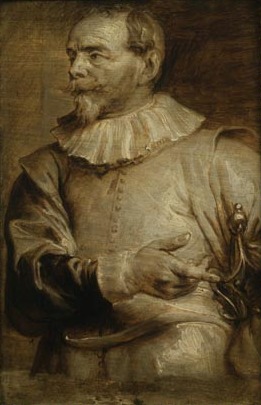
Sebastiaen Vrancx, Sebastiaan Vrancx or Sebastian Vranckx was a Flemish Baroque painter, draughtsman and designer of prints who is mainly known for his battle scenes, a genre that he pioneered in Netherlandish painting. He also created landscapes with mythological and allegorical scenes, scenes with robbers, village scenes and celebrations in cities. He was a gifted figure painter who was regularly invited to paint the staffage in compositions of fellow painters. As an active member of a local chamber of rhetoric, he wrote comedies and a number of poems. He was further captain of the Antwerp civil militia schutterij.

Artus Wolffort, Artus Wolffaert or Artus Wolffaerts (1581–1641) was a Flemish painter known mainly for his history paintings depicting religious and mythological scenes.

Jan Cossiers was a Flemish painter and draughtsman. Cossiers' earliest works were Caravaggesque genre works depicting low life scenes. Later in his career he painted mostly history and religious subjects as well as portraits. Cossiers was one of the leading painters in Antwerp after Rubens' death in 1640 and one of the most original colorists in 17th-century Flanders. He was an accomplished draughtsman who created some sensitive portrait drawings executed in a very varied and fluid manner.

Anton Goubau or Anton Goebouw was a Flemish Baroque painter. He spent time in Rome where he moved in the circle of the Bamboccianti, Dutch and Flemish genre painters who created small cabinet paintings of the everyday life of the lower classes in Rome and its countryside. He is known for his Italianate landscapes and genre paintings in the style of the Bamboccianti and his history paintings with mythological and religious themes.

Jan Baptist Bosschaert or Jan Baptist Bosschaert the Younger was a Flemish still life painter who is principally known for his decorative still lifes with flowers. He collaborated with figure artists on compositions which combined allegorical or mythological scenes with a still life element. He was active in Antwerp.
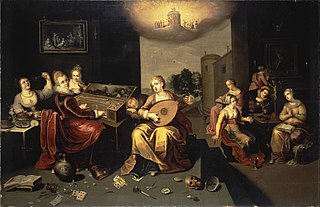
Hieronymus Francken the Younger or Hieronymus II was a Flemish painter and one of the most prominent members of the large Francken family of artists. Along with his brother Frans Francken II he played an important role in the development of new genres in Flemish art in the early 17th century. He was a prolific artist with a wide range who painted religious scenes, allegorical subjects, portraits, fruit pieces, genre scenes, architectural paintings and art galleries.
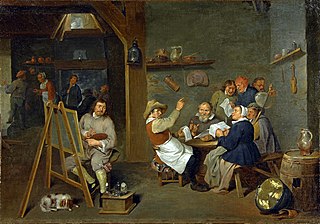
Mattheus van Helmont was a Flemish painter specialized in genre scenes of interiors and village scenes. His style and subject matter were influenced by the work of David Teniers the Younger and Adriaen Brouwer. His preferred subjects were peasant feasts, wedding celebrations, drinkers and alchemists. He developed his own personal style towards the final phase of his career. He spent most of his active life in Antwerp but moved to Brussels later.

Jan van Buken or Jan van Beucken was a Flemish painter mainly known for his genre paintings and still lifes.
Jan Baptist Tijssens the Younger (1660–1723) was a Flemish painter mainly known for his 'guardroom scenes' and still lifes. He was also active as an art dealer.

Abraham Teniers was a Flemish painter and engraver who specialized in genre paintings of villages, inns and monkey scenes. He was a member of artist family Teniers which came to prominence in the 17th century. He was also active as a publisher.

Emmanuel Noterman was a Belgian painter and printmaker known for his genre scenes, in particular his scenes with monkeys engaging in human activities, as well as for his paintings of dogs.
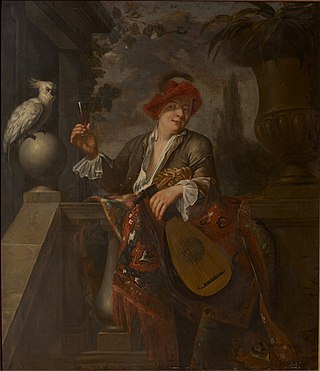
François Xaver Henri Verbeeck or Frans Verbeeck was a Flemish painter known mainly for his genre scenes and paintings of merry and gallant companies.

Victor Mahu was a Flemish painter active in Antwerp who specialized in genre painting. He is mainly known for his genre scenes of drinkers, card and board game players, dancers, musicians, peasants, cooks, and maids placed in tavern or kitchen interiors.

Huybrecht Beuckeleer, Huybrecht Beuckelaer or the Monogrammist HB was a Flemish painter who is mainly known for his genre paintings, still lifes and portraits. He was trained in Antwerp and also worked in Italy, France and England. In England he was court painter to Robert Dudley, 1st Earl of Leicester.

Jan Baptist Nollekens was a Flemish painter specialised in genre and still life paintings. His genre paintings depict scenes of drinkers, card players, peasants, merry companies and artist studios. His known still life paintings are hunting pieces. He was active in Flanders, the Dutch Republic, England and France.

Jan Baptist van der Straeten was a Flemish painter who specialized in architectural paintings depicting gallant companies amidst imaginary Renaissance and Baroque palaces and buildings.